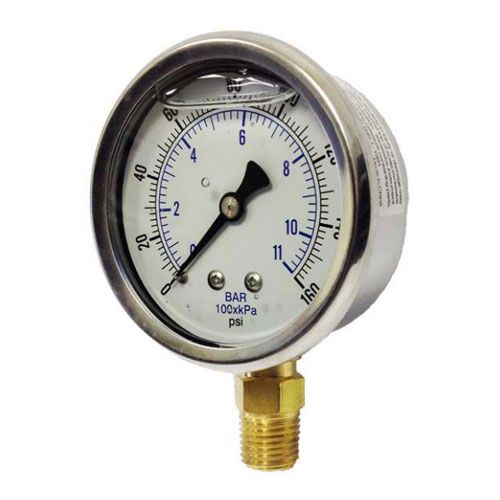 On high vibration industrial applications, reading a pressure gauge can often be frustrating or in some cases down right impossible without the proper configuration on the gauge. Very often, the end user may experience:
On high vibration industrial applications, reading a pressure gauge can often be frustrating or in some cases down right impossible without the proper configuration on the gauge. Very often, the end user may experience:
- The indicating needle shaking back forth making it difficult to get an actual reading
- The indicating falling off its access from the vibration
- Damage or short longevity of the gauge due to constant wear and tear of the pressure gauge internals
There are a few options that can be used to help legibility of the pressure gauge:
- Liquid Filling – Liquid filling the gauge with either a glycerin or silicone is easily the most popular solution and least expensive. The viscosity of glycerin or silicone makes it a thicker fluid than something water. With the case filled with glycerin, the needle has a harder time from shaking back forth from the vibration. This in turn steadies the needle and allows for accurate reading. In addition to help steady the needle, the glycerin also acts as a lubricant for the internals of the pressure gauge allowing for a longer life out in the field.
- Dampening Movement – Getting a pressure gauge with a dampening movement is the next best option especially for those who do not like liquid filling and prefer a dry gauge. A silicone dampener is put on the internals of the pressure gauge near the axis of the pointer. This steadies the pointer and allows for the same outcome as if the gauge was liquid filled. Typically a dampening movement needs to be special requested though
- Capillary Tubing with Diaphragm Seal – As an option for extreme vibrating applications where liquid filling and/or dampening movements aren’t enough, the pressure gauge is often mounted to a capillary tube and diaphragm seal filled system. The diaphragm seal is mounted at the process connection. Capillary tubing (often 5 feet in length) is connected to the diaphragm seal and on the other end of the tubing is the pressure gauge. The pressure gauge is then typically mounted to a wall or panel away from the vibration and a proper reading can be seen. The diaphragm seal, capillary, and gauge assembly is filled with a fluid (often silicone), to allow for an accurate reading.
For a complete list of our liquid filled gauge options, take a look at our mechanical gauges product page.

 PROCESS CONTROL & MEASUREMENT SOLUTION EXPERTS
PROCESS CONTROL & MEASUREMENT SOLUTION EXPERTS